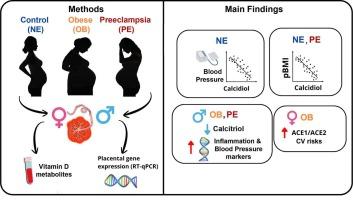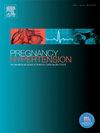Sexually dimorphic associations between Vitamin D metabolites, blood pressure, and placental inflammatory markers in Normoevolutive, preeclamptic and obese pregnancies
IF 2.9
4区 医学
Q2 OBSTETRICS & GYNECOLOGY
Pregnancy Hypertension-An International Journal of Womens Cardiovascular Health
Pub Date : 2025-08-28
DOI:10.1016/j.preghy.2025.101253
引用次数: 0
Abstract
Objectives
Calcitriol, the active vitamin D (VD) metabolite, abates inflammation and reduces blood pressure (BP). In the human placenta, calcidiol bioconversion into calcitriol is sexually dimorphic, resulting in differential VD-dependent effects. During pregnancy, obesity (OB) and preeclampsia (PE) have been linked to inflammation, hypertension, and impaired VD metabolism. Thus, this study aimed to analyze the relationships between these conditions, accounting for fetal sex.
Methods
A total of 142 mother–child pairs from normoevolutive (NE), OB and PE pregnancies were included. Calcidiol was quantified each trimester in maternal serum, while calcitriol was determined in umbilical cord serum after birth. Placental expression of relevant inflammatory and BP-modulatory genes was analyzed by RT-qPCR.
Results
In PE and OB, cord serum calcitriol was significantly reduced in male subgroups. Throughout pregnancy, maternal serum calcidiol negatively correlated with BP, but only in NE. PE placentas, especially those from males, had increased gene expression of pro-inflammatory and BP modulatory factors, compared to NE and OB. VD metabolites showed inverse correlations with inflammatory and hypertension-associated genes, as well as with pre-pregnancy body mass index (pBMI).
Conclusions
Maternal calcidiol levels negatively correlated with BP only in normoevolutive pregnancies. Both OB and PE groups presented elevated pBMI, alongside reduced umbilical cord calcitriol in male-bearing pregnancies, partially explaining the pro-inflammatory/hypertensive signature in their placentas. The results highlight a sexually dimorphic detrimental effect of obesity in placental VD-metabolism, while support the beneficial effects of maintaining an adequate VD nutritional status in pregnancy, particularly when carrying a male fetus.

正常进化、子痫前期和肥胖妊娠中维生素D代谢物、血压和胎盘炎症标志物的两性二态关联
目的骨化三醇是活性维生素D (VD)代谢物,具有减轻炎症和降低血压的作用。在人胎盘中,钙二醇向骨化三醇的生物转化是两性二态的,导致不同的dvd依赖效应。在怀孕期间,肥胖(OB)和先兆子痫(PE)与炎症、高血压和VD代谢受损有关。因此,本研究旨在分析这些条件之间的关系,考虑胎儿性别。方法选取正常妊娠(NE)、妊娠期(OB)和妊娠期(PE)的142对母子。每三个月定量测定母体血清中的骨化二醇,出生后测定脐带血清中的骨化三醇。RT-qPCR分析胎盘相关炎症和bp调节基因的表达。结果在PE和OB中,男性亚组脐血骨化三醇明显降低。在整个妊娠期间,母体血清钙二醇与血压呈负相关,但仅在新生儿期。与NE和OB胎盘相比,PE胎盘,尤其是男性胎盘,促炎因子和血压调节因子的基因表达增加。VD代谢物与炎症和高血压相关基因以及孕前体重指数(pBMI)呈负相关。结论母体钙二醇水平仅在正常妊娠时与血压呈负相关。OB组和PE组在男性妊娠中均出现pBMI升高,同时脐带骨化三醇减少,这部分解释了其胎盘中促炎/高血压的特征。研究结果强调了肥胖对胎盘VD代谢的性别二态性有害影响,同时支持了在怀孕期间保持足够的VD营养状态的有益影响,特别是在怀男性胎儿时。
本文章由计算机程序翻译,如有差异,请以英文原文为准。
求助全文
约1分钟内获得全文
求助全文
来源期刊

Pregnancy Hypertension-An International Journal of Womens Cardiovascular Health
OBSTETRICS & GYNECOLOGYPERIPHERAL VASCULAR-PERIPHERAL VASCULAR DISEASE
CiteScore
4.90
自引率
0.00%
发文量
127
期刊介绍:
Pregnancy Hypertension: An International Journal of Women''s Cardiovascular Health aims to stimulate research in the field of hypertension in pregnancy, disseminate the useful results of such research, and advance education in the field.
We publish articles pertaining to human and animal blood pressure during gestation, hypertension during gestation including physiology of circulatory control, pathophysiology, methodology, therapy or any other material relevant to the relationship between elevated blood pressure and pregnancy. The subtitle reflects the wider aspects of studying hypertension in pregnancy thus we also publish articles on in utero programming, nutrition, long term effects of hypertension in pregnancy on cardiovascular health and other research that helps our understanding of the etiology or consequences of hypertension in pregnancy. Case reports are not published unless of exceptional/outstanding importance to the field.
 求助内容:
求助内容: 应助结果提醒方式:
应助结果提醒方式:


